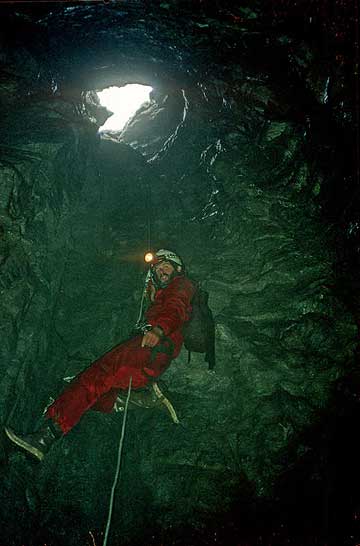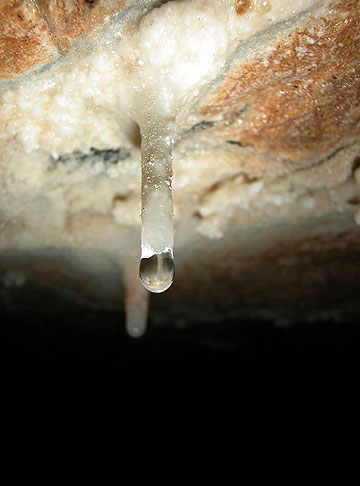 By GEOFF KIRSCH February 18, 2010
"What the hell would you want to crawl around in a cold, muddy pit for?" Fair enough, especially given the weather-and the hot spring beckoning across the street. Later, I discussed this exchange with long-time Tenakee resident Steve Lewis as we set out in his skiff for one of his favorite caves.
Lewis put it differently - "well, why wouldn't you?" Steve Lewis, 55, is one of the state's foremost cavers. In his 23 years as an explorer, 16 with the Tongass Cave Project, Lewis has measured and mapped many of the 500-plus known caves in Southeast Alaska. He is also an expert on karst. The term karst refers to landscape that forms in areas of water-soluble bedrock-in Southeast Alaska, typically limestone. Karst is distinguished by caves, pits, sink-holes and underground water drainage. As water eats away at rock, it begins to punch small holes. Over time, this process carves passages. "It's like dripping water onto a giant sugar cube," Lewis said, steering us into a small cove on northern Chichagof Island. Limestone is especially soluble. Even rainwater will dissolve it; muskeg and forest soil run-off can be extremely acidic. This hastens the creation of limestone caves in boggy or wooded areas-Southeast Alaska is both. "Of course, the dissolved limestone makes karst-fed streams less acidic," Lewis said. "There's usually lots of salmon." He wasn't kidding. We anchored near the mouth of one such stream thick with sockeye, the bank covered in scales and entrails. It stank like a processing plant. Lewis gestured up the shoreline into the trees, I thought pointing out a bear. But he indicated something else-a sharp change in vegetation, dark forest on one side, bramble on the other. "That's a clear-cut," Lewis said, and led us upstream along an extremely primitive trail-bear-made, I later found out. While most forests in Southeast Alaska suffer poor drainage, he explained, karstland forests sit on a huge colander. Better drainage makes for larger trees. Not surprisingly, karst areas in the Tongass have been heavily harvested. "And because the soil is so thin, it's hard to re-grow trees in karst areas," he said. Underbrush, however, thrives. Our cave was on the clear-cut side-it took an hour to walk a mile. Prince of Wales Island boasts the region's best-known and most extensively explored karstlands. It is home to El Capitan Cave, Alaska's longest cave, and El Capitan Pit, the deepest limestone pit in the U.S. Along with Cavern Lake Cave, also on Prince of Wales, El Capitan is one of only two karstland caves in the Tongass National Forest designated for public access. "Karst on Prince of Wales has felt the biggest impact of logging," Lewis said. We had reached our cave's "entrance"-a muddy chute descending steeply into darkness. Steve Lewis doesn't "spelunk," he explained as he prepared helmets, headlamps, ropes, first-aid gear, and most importantly, pepper spray. It was hard to tell whether the splashes from the pool below were sockeye or something feeding on them. "Spelunking is a bunch of guys blundering around with a six-pack," Lewis said, nimbly lowering himself down the same line I slithered on my belly. "This is caving." The karst was spectacular. The limestone had become marble, sparkling bands of white, black and grey as slippery as any wet marble floor, and deeply pitted. "See how fragile it is?" Lewis said. I'd stumbled, accidentally chipping a small piece. To be fair, karst is under constant destruction. But over-harvesting kastland can speed natural erosion, sometimes rapidly. Later, inside a different part of the cave, Lewis motioned to a screw imbedded in the limestone to measure how quickly it is dissolving. In some parts of Southeast, this can be more than a half-inch each decade. Meanwhile, above ground, the rain picked up. Previously dry spots suddenly filled mid-calf with water. Along with loose rock and hypothermia, flash flooding represents a major danger of caving in Southeast Alaska. "We should go," Lewis said, pointing to a band of gunk-a recent water line- just inches from the cave's ceiling. I didn't argue. Before we pulled anchor, Lewis wanted to be sure I understood that he wasn't against logging. He simply favors better management practices. Chief among these: adopting statewide guidelines protecting karst-similar to those implemented by the Tongass National Forest-which would protect caves on private lands. "We just have to be responsible," Lewis said. And then we were off to his
other job-photo-ID'ing humpback whales for the University of
Alaska Southeast, Sitka.
Geoff Kirsch ©2010 To republish this article, the author requires a publication fee. Publish A Letter in SitNews Read Letters/Opinions
|
|||

